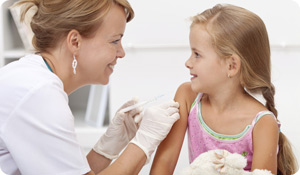
Few current health topics are as fraught as vaccines. Fueled by the U.S. measles outbreak, which involves roughly 175 people in 17 states and Washington, D.C. and can be traced to an infected foreign tourist who visited California’s Disneyland last December, parents and healthcare providers nationwide have been engaged in a vocal debate about the necessity and safety of vaccinations. This has been especially true in communities where a large percentage of children remain unvaccinated due to their parents’ religious beliefs or health fears, and where it can be tough to sort fact from fiction.
On January 1 of this year, the Centers for Disease Control and Prevention (CDC) issued new recommendation guidelines for vaccines, beginning with the first dose of the hepatitis B vaccine at birth and continuing through childhood and the teen years (and beyond) with vaccines for diseases such as tetanus, measles, mumps, chicken pox, hepatitis A, meningitis, the flu, human papilloma virus (HPV) and more. Here are answers to five of the most pressing questions about vaccines.
1. Do people really need vaccines?
The answer is a resounding "yes," according to the Centers for Disease Control, the American Academy of Pediatrics, the American Academy of Family Physicians and the American College of Obstetricians and Gynecologists. "Vaccines are important for one simple reason—they prevent disease," says David Levine, MD, FAAP, a pediatrician with Summit Medical Group in Westfield, N.J. "They do not enrich doctors and pharmaceutical companies. They protect people, especially the most vulnerable."
2. Why are certain vaccines given at certain times?
The youngest people in our society are particularly vulnerable to infection due to immature immune systems, so it makes sense to administer vaccines as early as possible, Levine says. But a carefully planned timetable is key: "Vaccines are studied endlessly, as well as which combinations work and which do not," he says. "We know that some vaccines do not work at young ages, such as MMR (the vaccine that protects against measles, mumps and rubella), so it is usually given at 12 to 15 months and not at two months, whereas the polio vaccine works very well at a young[er] age." The hepatitis B vaccine is recommended even earlier—at birth. This is because pregnant women may not be screened for the disease, and without the vaccine, a baby born to a woman who has hepatitis B has a 90 percent chance of becoming infected and may suffer liver damage over time.
3. What is herd immunity and how does it relate to vaccines?
You may have heard of this concept. Herd immunity, or community immunity, means that enough of the population is vaccinated to prevent an outbreak of disease—even in non-vaccinated members. If too many people are unvaccinated, then when a disease is introduced into the area there is a significant risk that susceptible people will contract it. According to Levine, this is exactly what happened with the measles outbreak that originated in California—someone introduced measles into the community and not enough people were vaccinated to prevent an outbreak.
As measles is highly contagious—each person with the disease can infect up to 15 people who are unvaccinated—the infection spread quickly. The number of people that need to be vaccinated in order to prevent infection in others (the herd immunity "threshold") varies from disease to disease. For instance, 95 percent of people need to be vaccinated against measles to prevent an outbreak, according to the University of Oxford’s Vaccine Knowledge Project. On the other hand, an article in The Journal of Infectious Diseases notes that a slightly lower percentage (approximately 90-92 percent) of people need to be vaccinated to confer herd immunity against mumps, another once-common childhood disease.
5. Are vaccines safe for everyone?
There are some members of the population who should not receive vaccines. They include those who have had negative reactions to previous vaccines, people on immunosuppressants [drugs that suppress the immune system; transplant recipients, for instance, take immunosuppressants so that their bodies will not reject the organ] and people with certain chronic illnesses. "This is where herd immunity comes in," Levine says, adding that ideally about 95 percent of the population will be vaccinated. "[Then] we are able to protect people too sick to be vaccinated, [or] too young to be vaccinated, as well as those who refuse vaccines. The act of vaccinating is selfless. We are protecting our own to protect everyone."
6. What are some potential side effects of vaccines?
"Side effects may include fever, redness at the site of the shot and generalized body aches," Levine says.
David Levine, MD, FAAP, reviewed this article.
Sources
Levine, David, MD, FAAP. Interviewed March 9, 2015.
"Recommended Immunization Schedules for Persons Aged 0 Through 18 Years." Centers for Disease Control and Prevention. Accessed March 16, 2015.
"Hepatitis B and the Vaccine (Shot) to Prevent It." Centers for Disease Control and Prevention. Accessed March 15, 2015.
"Community Immunity (“Herd Immunity”)." Vaccines.gov. Accessed March 16, 2015.
"Herd Immunity." Oxford Vaccine Group/Vaccine Knowledge Project. Page last updated March 9, 2015.
"U.S. Multi-State Measles Outbreak 2014-2015." Centers for Disease Control and Prevention. Accessed March 15, 2015.
"Measles Cases and Outbreaks." Centers for Disease Control and Prevention. Accessed March 15, 2015.
"Measles." California Department of Public Health. Accessed March 17, 2015.
Kutty, Preeta K., et al. "Seroprevalence of Antibody to Mumps Virus in the US Population, 1999–2004." Journal of Infectious Diseases 202, 5 (2010): 667-674.





